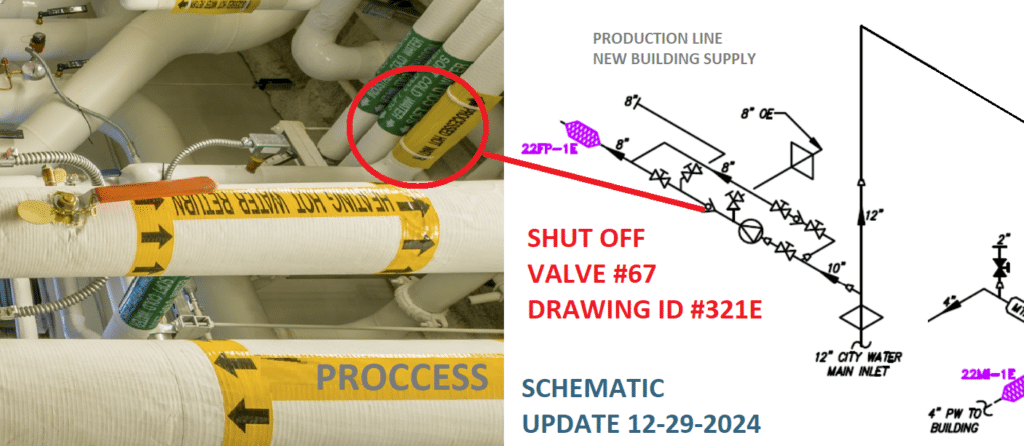
Summary:
- Piping schematics are vital tools for facility managers and maintenance supervisors, providing a crucial overview of their piping systems and guiding quick responses during emergencies, minimizing downtime, and enhancing overall operational efficiency.
- By updating these schematics regularly, they enable proactive risk mitigation by clearly documenting every detail of any piping system, especially in the case of system addition or expansion.
- Beyond crisis management, accurate schematics contribute to overall emergency preparedness, ensuring that maintenance employees are well-versed in the facility’s infrastructure for a coordinated and effective response during high-stress emergency situations.
As any facility manager or maintenance supervisor could tell you, emergency situations involving the building’s infrastructure will inevitably arise. Whether there is a leak in the potable water system or a breakdown in the compressed air piping, issues will need to be responded to – and fast – in order to mitigate any potential downtime. An efficient emergency response relies on having the proper information readily available to direct maintenance and repair crews directly to the source of the problem and to the solution. Here’s how having and maintaining updated, as-installed piping schematics of all your piping systems leads to a highly effective emergency response to any piping problems:
Find Out the ROI of Piping Schematics for Your Facility
Outdated Piping Schematics Handicap Facility Operations
Maintenance and safety protocols become hindered when piping schematics are unreliable. Accurate piping schematics serve as the foundation for a facility’s infrastructure management. Having precise schematics of all a facility’s piping systems is like having a roadmap to navigate through crises. These diagrams provide a visual representation of the intricate network of pipes, valves, and connections, offering a comprehensive overview of the facility’s plumbing and utility systems. Furthermore, as buildings expand or different areas of the facility/plant are repurposed, piping systems change along with them. This requires maintaining up-to-date schematics by conducting surveys routinely and ensuring that the schematics represent the current systems accurately.

Potable Water Plumbing
Whether water is used in the manufacturing process or not, ensuring a safe and reliable water supply is paramount. Accurate potable water plumbing schematics empower facility managers to quickly identify the main water lines, shut-off valves, and potential points of contamination in the form of cross-connections. While these should all be isolated by backflow preventers, being able to pinpoint the location of these assemblies is critical. When experiencing a water main break or backflow incident, having detailed schematics allows for efficient isolation of affected areas and the rapid implementation of corrective measures. This proactive approach not only mitigates risks to occupants but also safeguards the integrity of the facility’s water supply, avoiding crises that could cause employee illness or any manufacturing shutdown.
Compressed Air Piping
Compressed air is a critical utility in various industrial and commercial settings, powering tools, controls, and processes. During emergencies, such as equipment failure or leaks, having accurate compressed air piping schematics is akin to having a detailed manual on hand. Facility managers can swiftly identify the affected areas, isolate the problem, and implement necessary repairs. When unexpected equipment malfunctions, detailed schematics ensure a rapid response, minimizing downtime, and maintaining operational efficiency.
Process Fluid Piping
For facilities that convey process fluids for production and operations, having trustworthy schematics of each system is essential. Detailed schematics enable facility managers to pinpoint the source of the system breakdowns, activate emergency shut-off valves, and deploy containment measures promptly, minimizing environmental impact, loss of functionality, and potential legal repercussions.

Enhancing Emergency Preparedness
Accurate piping schematics are not just tools for crisis management; they are crucial elements of a facility’s overall emergency preparedness plan. Regularly updated schematics provide an ongoing snapshot of the facility’s infrastructure, aiding in the identification of vulnerabilities and potential risks. This ensures that facilities are not just reacting to crises but are proactively mitigating risks and safeguarding against potential disasters, especially when it comes to adding new piping systems or expanding existing systems.
Enable Your Maintenance Team
In emergency situations, time is a critical factor. Having a well-trained response team familiar with the facility’s piping can make all the difference. Regular training sessions that involve hands-on familiarization with the schematics, including recognizing legend symbols and knowing where the schematics are kept, enable response teams to quickly locate essential components and take decisive actions. This ensures a coordinated and effective response during high-stress situations that can mitigate the amount of downtime caused by any piping issues or emergencies.

Call To Action
When it comes to outlining emergency response plans for any issues or breakdowns in piping systems, accurate and up-to-date piping schematics emerge as indispensable tools for facility managers and maintenance supervisors. These blueprints not only guide responses in times of crisis but also serve as proactive instruments for risk mitigation when updated regularly. Detailed schematics ensure that facilities navigate emergencies with precision, resilience, and a commitment to the safety and well-being of occupants, the environment, and the bottom line.


